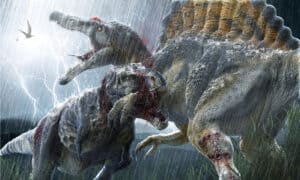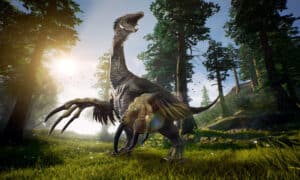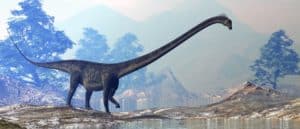Dinosaurs have always fascinated us with their impressive size and mysterious existence. One aspect that makes them even more interesting is their unique and often tongue-twister names. Unlike animals that live in the modern era, most dinosaurs only have a scientific name, so their names are a mouthful! Some dinosaur names are so long and complex that it can be challenging to pronounce them correctly.
Below, we will explore the top 10 longest dinosaur names given to these ancient creatures. Get ready to expand your dinosaur vocabulary and discover the longest and most unique names in the paleontological world.
Micropachycephalosaurus
Here it comes, the longest name in the world of the dinosaurs—micropachycephalosaurus. This 23-letter name means “small, thick-headed lizard.” These little guys were found in Asia during the late Cretaceous period. They had a unique skull shape and were more closely related to horned dinos like triceratops.
These tiny dinosaurs had an average length of only 2.5 feet (0.8 meters). They may have been small, but micropachycephalosaurus were fierce predators. They probably hunted in packs and feasted on small reptiles and mammals with their sharp teeth. Even though they were small, they were not to be messed with.
Fossils of these dinosaurs have been discovered in China’s Shandong Province, and it’s believed they roamed the Earth around 69 million years ago.
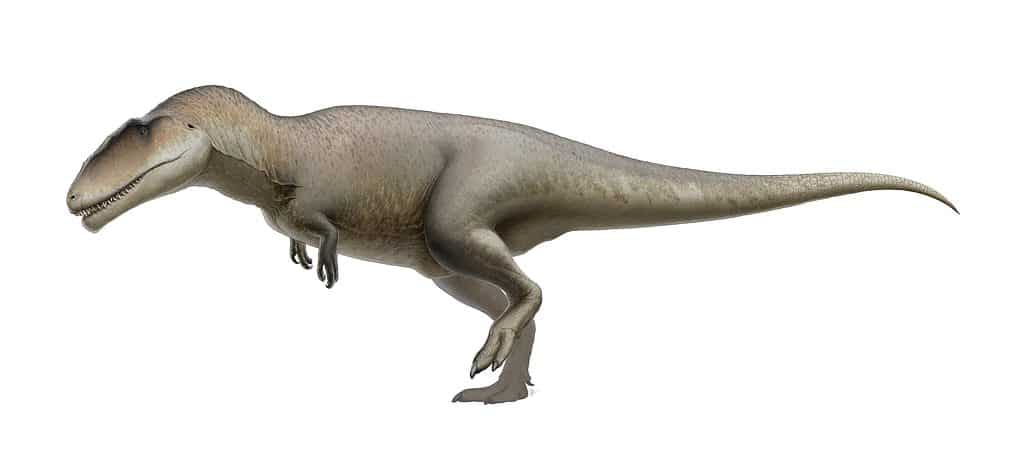
Carcharodontosaurus is estimated to have been 44 feet long and weighed up to seven tons.
©Fred Wierum | CC BY-SA – License
Carcharodontosaurus
The carcharodontosaurus has a 19-letter name that translates to “shark tooth lizard.” This beast roamed the Earth 165 million years ago. Its massive jaw and sharp teeth made it a formidable predator that could inflict severe wounds on its prey. It’s believed it was primarily a visual hunter, but it may have also used its sense of smell to locate its next meal.
Initially, the fossil evidence for the carcharodontosaurus was limited. Unfortunately, the fossils of this predator were destroyed during World War II, leaving paleontologists to rely on written descriptions. However, in 1996, new fossils were discovered that were more extensive than the original specimen.
This giant predator lived during the mid-Cretaceous period and was close in size to the giganotosaurus. It’s estimated to have been 44 feet long and weighed up to seven tons. Its savage jaws, lined with eight-inch serrated teeth, made it a top predator of its time.
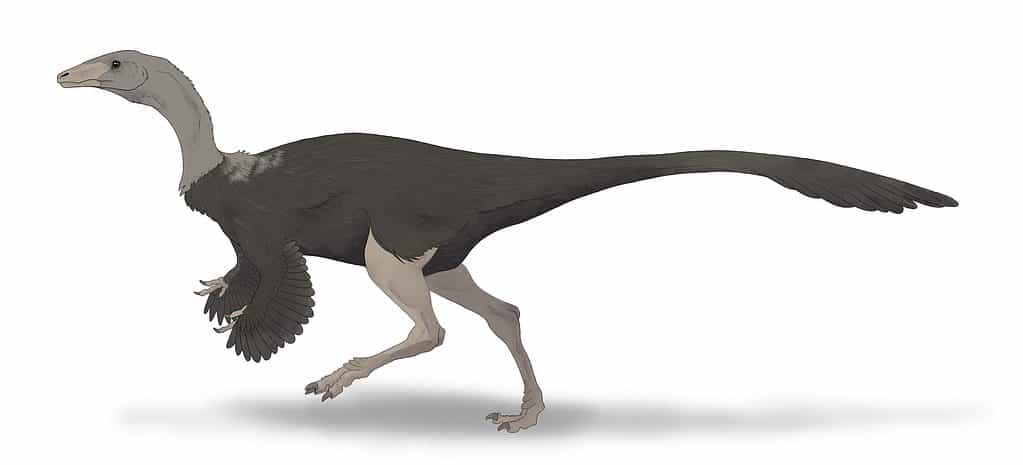
Archaeornithomimus is a theropod that lived around 80 million years ago in modern-day Mongolia.
©Audrey.m.horn | CC BY-SA – License
Archaeornithomimus
Among the longest dinosaur names is archaeornithomimus (18 letters), a theropod that lived around 80 million years ago in modern-day Mongolia. It weighed about 500 pounds (227 kilograms) and was about 10 feet (3 meters) long. The name “Arkheios” is derived from the Greek words for “ancient” and “Ornithomimos,” meaning “bird mimic.” The fossils of archaeornithomimus were discovered in Mongolia and Uzbekistan in 1972.
Among the most bird-like dinosaurs that ever lived, archaeornithomimus belongs to the Ornithomimidae family. With long legs and small heads, these dinosaurs had beak-like mouths. It is possible they could run on both two and four legs, as they were relatively lightweight and fast runners.
Looking at this dinosaur, we can observe the evolutionary transition from dinosaurs to birds. It is known to be one of the first dinosaurs to have been related to birds.
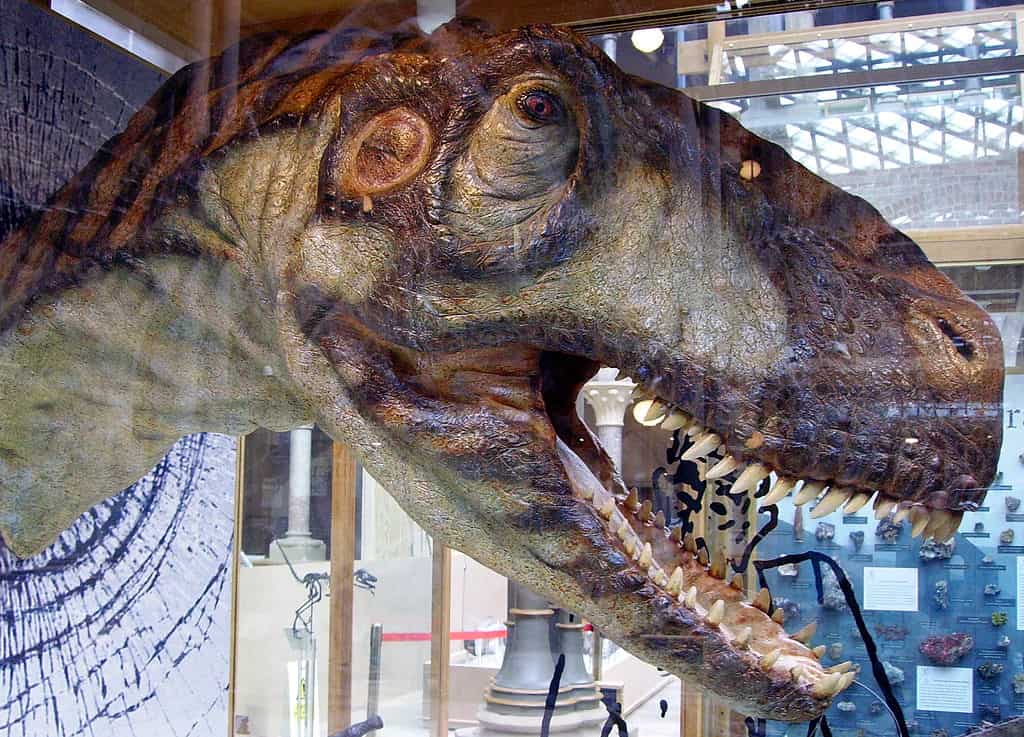
Eustreptospondylus was equipped with small forelimbs and powerful hind limbs.
©Ballista at English Wikipedia | CC BY-SA – License
Eustreptospondylus
The eustreptospondylus, a member of the theropod family, roamed the lands of southern England during the late Jurassic period. Its name has 18 letters, is derived from the Greek language, and translates to “true, well-curved vertebrae,” which is a nod to its distinct skeletal structure.
Discovered in 1870 before the establishment of proper dinosaur classification systems, the eustreptospondylus was initially thought to be a species of megalosaurus. However, it was later recognized as a separate genus in 1964.
Measuring approximately 15 feet in length and weighing around 1,000 pounds, this bipedal carnivore was equipped with small forelimbs and powerful hind limbs. As a member of the Stegosauridae family, which includes well-known dinosaurs such as triceratops and stegosaurus, the eustreptospondylus was characterized by its armored plates and spiked tail.
Although smaller in size compared to other members of its family, the eustreptospondylus was still a formidable predator, using its sharp teeth and claws to tear apart its prey. Its unique skeletal structure, precisely the number and placement of spikes along its spine set it apart from other dinosaurs of the Stegosauridae family.
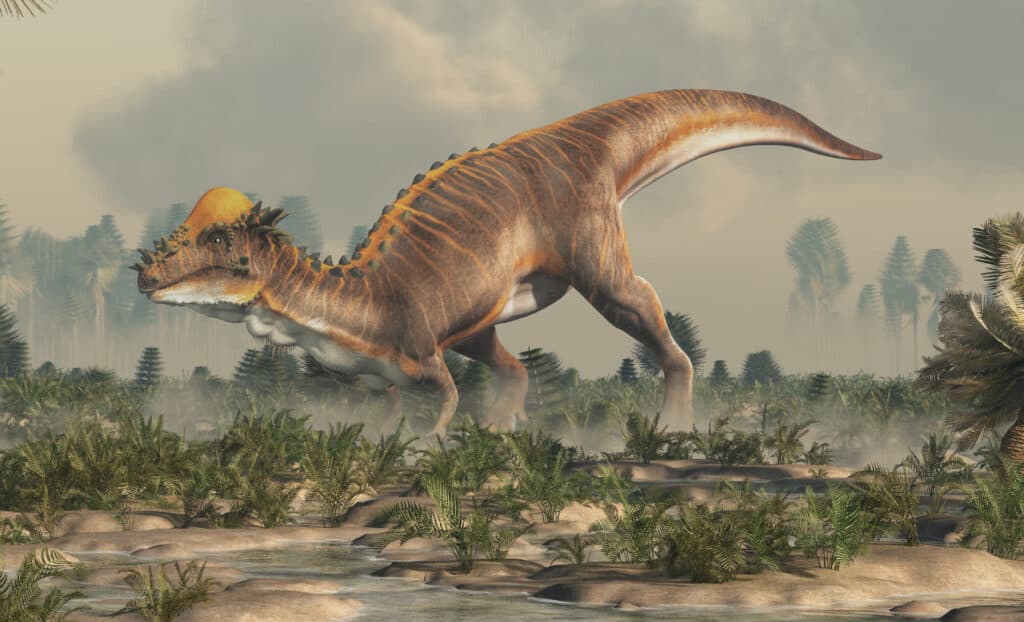
The pachycephalosaurus was most likely a two-legged creature.
©Daniel Eskridge/Shutterstock.com
Pachycephalosaurus
The pachycephalosaurus once lived with other giants during the late Cretaceous period in North America. Despite sharing a similar name to the micropachycephalosaurus, it is not believed to be related. The name pachycephalosaurus is 18 letters long and means “thick-headed lizard.”
The first fossils of the pachycephalosaurus to be discovered were its large, domed head, which was initially mistaken for the kneecaps of larger dinosaurs. The dinosaur has a history of confusing theories, and its remains may have been found as early as the 1850s in southeastern Montana.
The diet of the pachycephalosaurus is not well understood. It had tiny, ridged teeth, making it unlikely to have effectively chewed tough, fibrous plants like flowering shrubs.
Despite the general belief that sauropods were strictly herbivorous, recent discoveries have led experts to question this assumption. Fossil evidence suggests this particular dinosaur may have had a varied diet consisting of leaves, fruits, and seeds, with the possibility of incorporating meat into its meals.
This theory is supported by the discovery of a complete fossil jaw displaying serrated, blade-like front teeth similar to carnivorous theropod dinosaurs. This finding has sparked a new wave of research and hypotheses about the dietary habits of sauropods.
The pachycephalosaurus, a massive member of the pachycephalosaurid family, was most likely a two-legged creature. As the largest of its kind, this dinosaur was estimated to have been roughly 15 feet long and weighed between 820-990 pounds. It had a formidable presence during its time, leaving a lasting impression on the ancient landscape.
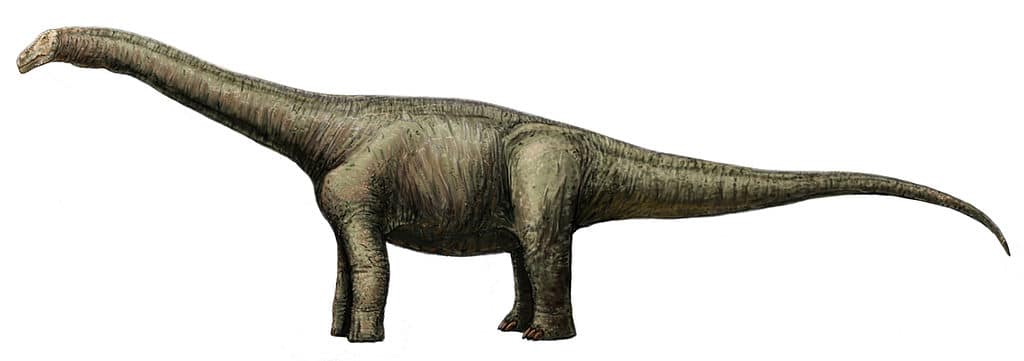
Opisthocoelicaudia was a majestic sauropod of the late Cretaceous period.
©FunkMonk (Michael B. H.) | CC BY-SA – License
Opisthocoelicaudia
The opisthocoelicaudia (18 letters), a majestic sauropod of the late Cretaceous period, was an exciting discovery made by Polish and Mongolian scientists in 1965. This dinosaur roamed the Earth at an impressive 39 feet in length during the Cretaceous period. Its remains were dug up in the Gobi Desert of Mongolia, which was once home to lush jungles and murky marshes and is now a barren desert region. The discovery of this ancient creature offers a glimpse into the past and a chance to understand the diversity of life that existed millions of years ago.
The discovery of the new genus in 1977 by Borsuk-Białynicka was initially identified as a camarasaur. Still, as research progressed, the animal was reclassified as a saltasaurid titanosaur by paleontologists Salgado and Coria in 1993. However, the fossil remains were incomplete, lacking a skull and neck, and the carcass had disintegrated before being buried, leaving scientists with a blurry image of what the head and neck of the creature would have looked like.
The incomplete nature of the discovery raises more questions and offers a glimpse into the complexity of prehistoric life. Borsuk-Białynicka suggests the carcass was likely scavenged by tyrannosaurids, leaving tooth marks on the pelvis and femur.
The skeletal structure of opisthocoelicaudia, similar to many other titanosaurs, is noteworthy for the presence of significant ligament and muscle tissue on its tail. This results in a tail that slants slightly upwards rather than downwards, hinting at the possibility that it was used as a support to form a tripod with its hind limbs, enabling the dinosaur to reach high foliage.
Panamericansaurus
A titanosaurian sauropod dinosaur named the panamericansaurus (17 letters) roamed Argentina during the late Cretaceous period. Jorge Orlando Calvo and Juan Domingo Porfiri named and described this dinosaur in 2010. Pan American Energy financially supported the paleontological investigations and research.
Now bearing the name of the energy company, this creature offers a glimpse into the past and the diversity of life that existed millions of years ago.
The holotype, MUCPv-417, was uncovered in 2003 and comprises a sacral vertebra, five tail vertebrae, a left humerus, rib fragments, and haemal arches. The humerus alone is 48 inches in length, and based on this measurement, scientists estimate the overall size of the individual dinosaur to be 36 feet.
This impressive discovery offers valuable insights into the size and structure of this ancient creature and provides a glimpse into the world of the past.
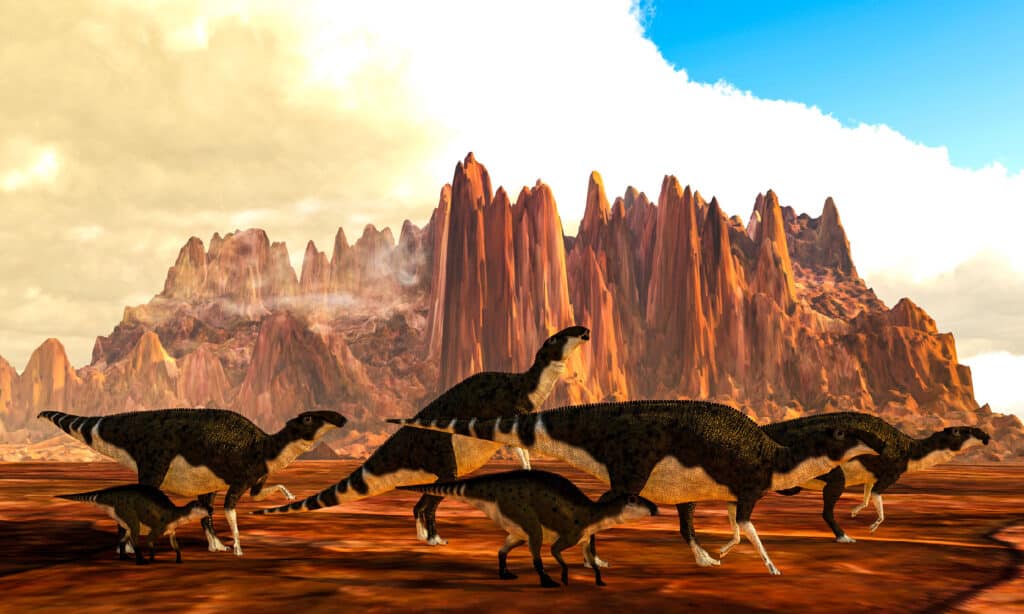
One of the most notable features of the brachylophosaurus is its relatively small head.
©iStock.com/CoreyFord
Brachylophosaurus
Brachylophosaurus, also known as “short-crested lizard,” was a mid-size member of the Hadrosaurid family that existed around 81-76.7 million years ago. This dinosaur was given a 17-letter name and is well-documented by several skeletons and bonebed material found in the Wahweap Formation of Utah, the Oldman Formation of Alberta, and the Judith River Formation of Montana.
With its unique crest, this dinosaur has provided valuable insights into the diversity of life that existed during the late Cretaceous period and continues to fascinate scientists and dinosaur enthusiasts alike.
A recent examination of the renowned dinosaur mummy Leonardo has shed light on the dietary habits of the brachylophosaurus. The study revealed that this dinosaur had a diverse plant-based diet that consisted of conifers, ferns, leaves, and flowering plants such as magnolias. The findings indicate that the brachylophosaurus was a generalist herbivore, and it could adapt its diet by browsing and grazing, but it primarily relied on browsing. This dinosaur mummy can be seen at the Children’s Museum of Indianapolis.
One of the most notable features is its relatively small head, which was a strange characteristic for a dinosaur of its size. Its lower arms were also unusually long, which added to its distinctiveness. Additionally, the beak on its upper jaw was wider than other hadrosaurs of its time.
Reaching an adult length of at least 30 feet, it stood tall among its peers, an imposing presence in the ancient landscape.
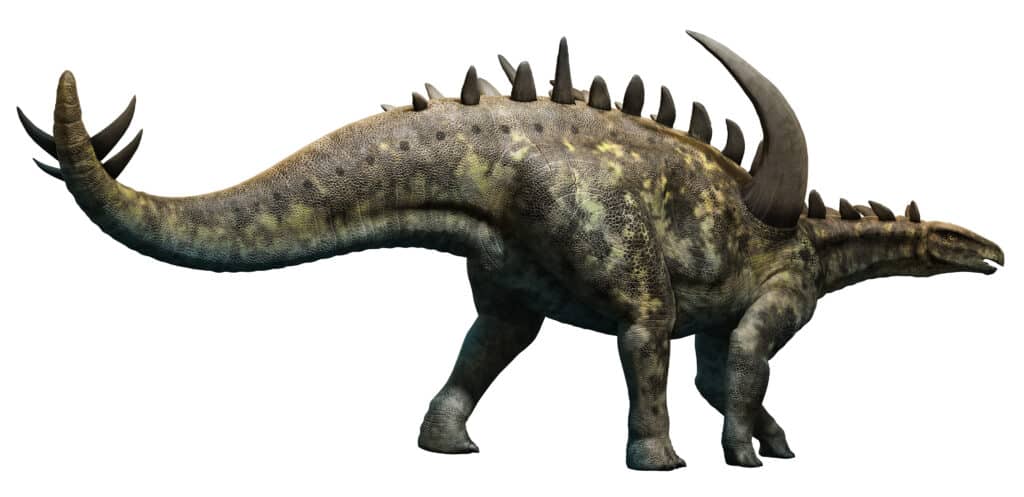
Gigantspinosaurus was named for the large spines protruding from its shoulders.
©Warpaint/Shutterstock.com
Gigantspinosaurus
Gigantspinosaurus, a unique stegosaur, stood out from its relatives due to its enormous shoulder spikes. These spikes may have served as a form of defense or as a way to attract mates. Scientists believe the Stegosauria family originated in Asia before spreading to Africa, Europe, and North America.
The first gigantspinosaurus was discovered in 1985 by paleontologist Ouyang Hui at Pengtang near Jinquan. Initially, it was mistaken for a specimen of tuojiangosaurus but was later properly identified by Gao Ruiqi and colleagues in 1986. In 1992, Ouyang described and named the species Gigantspinosaurus sichuanensis in an abstract of a lecture.
According to an estimation in 2010, this dinosaur was approximately 14 feet long and weighed 1,500 pounds.
The dinosaur was a marvel of nature, boasting unique physical characteristics that set it apart from others. The small dorsal plates were in stark contrast to the greatly enlarged shoulder spines that rested on large flat bases, twice the length of its shoulder blades. The triangular plates on its neck added to its distinct appearance, as did its relatively large head and 30 teeth in each lower jaw.
Gigantspinosaurus is a 17-letter name that means “giant-spined lizard.”
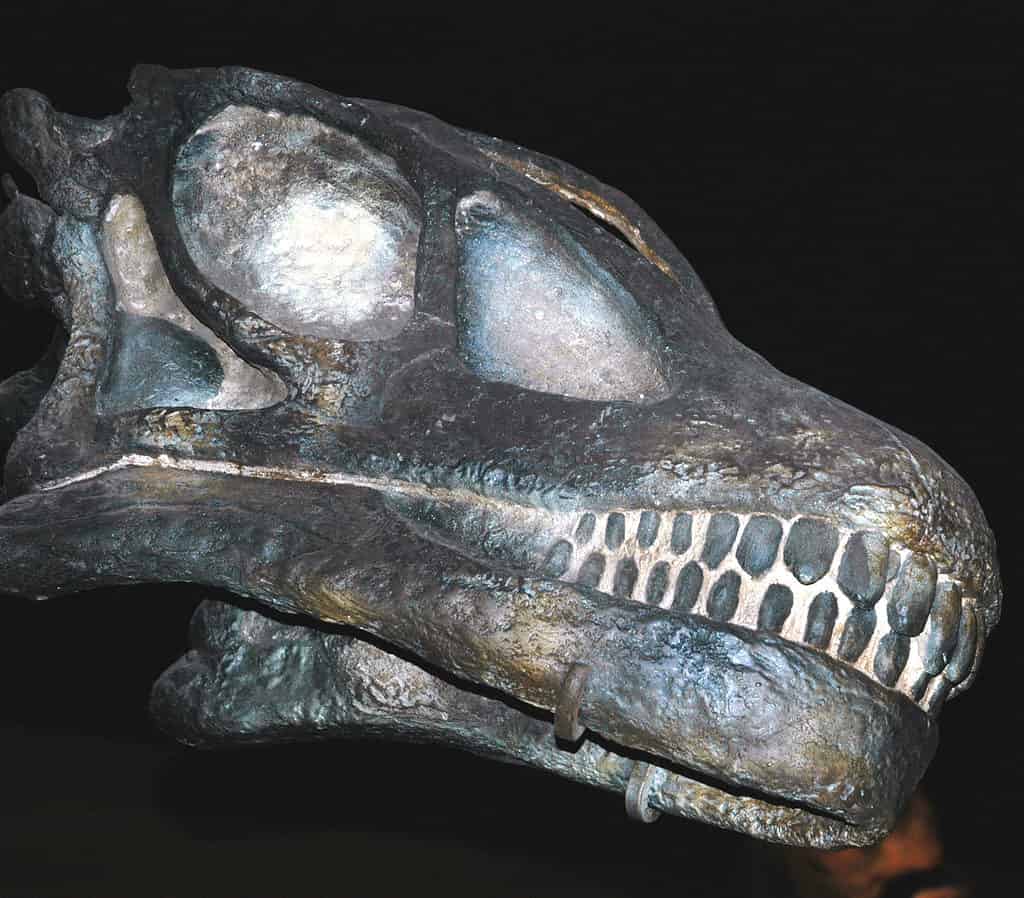
Haplocanthosaurus was relatively small, reaching a maximum length of 49 feet.
©James St. John / Flickr – License
Haplocanthosaurus
Haplocanthosaurus, a 17-letter name that translates to “simple spined lizard,” was an intriguing genus of intermediate sauropod dinosaur that existed during the late Jurassic period between 152-155 million years ago. A partial dinosaur skeleton can be viewed at the Cleveland Museum of Natural History alongside a replica skull, as a skull specimen has yet to be found.
Compared to other sauropods of the Morrison Formation, haplocanthosaurus was relatively small, reaching a maximum length of 49 feet. In comparison, many Morrison sauropods could grow to over 66 feet in length.
The habitat of these dinosaurs is believed to have been dense forests, grasslands, and rocky mountains. They were gregarious creatures and lived in groups.
Sauropods, in general, were herbivores and fed on plants and leaves. Since haplocanthosaurus was smaller, it likely ate plants closer to the ground, unlike larger sauropods which fed from the tallest trees. This creature had broad flat teeth that helped to chew plant material.
Summary of the 10 Longest Dinosaur Names
Here are the 10 Longest Dinosaur Names:
| Rank | Dinosaur Names |
|---|---|
| 1 | Micropachycephalosaurus |
| 2 | Carcharodontosaurus |
| 3 | Archaeornithomimus |
| 4 | Eustreptospondylus |
| 5 | Pachycephalosaurus |
| 6 | Opisthocoelicaudia |
| 7 | Panamericansaurus |
| 8 | Brachylophosaurus |
| 9 | Gigantspinosaurus |
| 10 | Haplocanthosaurus |
The photo featured at the top of this post is © Ballista at English Wikipedia | CC BY-SA – License / Original
Thank you for reading! Have some feedback for us? Contact the AZ Animals editorial team.



